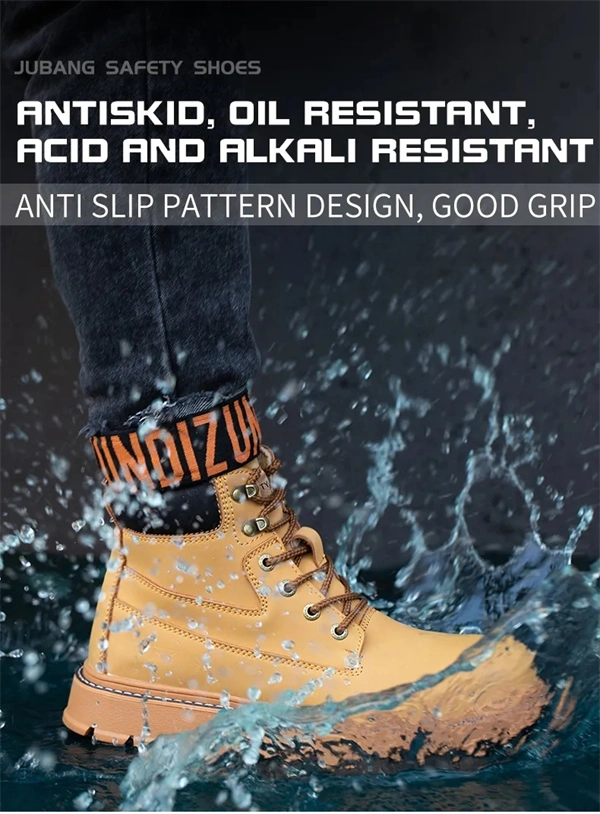
How These Boots Kept Me Steady in a Chemical Spill: A Waterproof Safety Boot Review
I never thought I’d be grateful for my work boots until I was standing ankle-deep in industrial solvent. Let me tell you, when you hear someone yell “SPILL!” in a chemical processing facility, your footwear suddenly becomes the most important gear you own.
The Day My Work Boots Saved My Skin (Literally)
It was just another Tuesday at the plant where I’ve been working as a chemical safety supervisor for the past 8 years. We were transferring a batch of caustic cleaning solution when a valve malfunctioned. Before anyone could react, there was a puddle of pH 12 industrial cleaner spreading across the floor, and I was standing right in the middle of it.
In those crucial seconds, two thoughts flashed through my mind: “This could cause serious chemical burns” and “Thank god I’m wearing these boots.”
While my colleagues scrambled for the emergency shower, I calmly helped contain the spill. Why? Because not a single drop had penetrated my Waterproof Safety Work Boots. The thick rubber sole and treated super fiber leather upper created an impenetrable barrier between my skin and what could have been a trip to the emergency room.
That day changed how I view PPE (Personal Protective Equipment). It’s not just about compliance—it’s about coming home with all your skin intact.
Finding Reliable Protection After Too Many Close Calls
Before discovering these boots, I’d cycled through countless “safety” footwear options that promised protection but delivered compromises. My previous pair had decent water resistance but left my toes vulnerable. The pair before that had solid toe protection but leaked like a sieve when exposed to liquids.
After a particularly nasty incident where a colleague suffered chemical burns despite wearing “waterproof” boots, our entire team went searching for truly reliable footwear. That’s when I discovered these Waterproof Safety Work Boots with their comprehensive protection features.
What Makes These Boots Different: A 6-Month Test in Harsh Conditions
First Impression: Serious Protection You Can Feel
When I first pulled these boots from the box, their substantial construction was immediately apparent. Unlike lightweight options that feel flimsy, these had a reassuring solidity without being unnecessarily heavy. The steel toe didn’t pinch (a common problem with safety footwear), and the braided rope belt system made adjusting the fit surprisingly easy.
Week One: The Comfort Surprise
The first week wearing new safety boots is typically an exercise in endurance—blisters, hot spots, and general discomfort. These broke that pattern. The ventilated inner lining prevented the sweaty-foot syndrome that plagues most waterproof footwear, while the breathable insole provided unexpected cushioning during 12-hour shifts on concrete floors.
My coworker Dave (notorious for complaining about every boot he’s ever worn) borrowed mine when he forgot his. His exact words: “Damn, it’s like wearing tactical gear that doesn’t hate your feet.”
The Three-Month Mark: Durability Test
Three months into wearing these boots daily in a chemical manufacturing environment—where floors are regularly exposed to acids, bases, oils, and solvents—the exterior showed minimal wear. The anti-slip pattern maintained its grip even on surfaces that would send regular boots sliding, and the thick rubber sole showed no signs of degradation despite constant exposure to corrosive substances.
A crucial observation: while other boots in our facility typically show deterioration at the seams when exposed to chemical splashes, these maintained their structural integrity without compromise.
The Six-Month Verdict: Performance Under Pressure
Six months of daily wear in one of the harshest industrial environments possible has convinced me these boots aren’t just good—they’re potentially life-saving. The combination of features that initially seemed like marketing points proved their worth repeatedly:
- Super Fiber Leather Upper: After countless chemical exposures, not a single instance of material degradation or penetration
- Anti-Smashing Steel Head: Protected my toes when a 55-gallon drum shifted unexpectedly during transport
- Kevlar Stab-Proof Midsole: Prevented puncture when I stepped on a nail protruding from a pallet
- Wear-Resistant Rubber Sole: Maintained traction on slippery surfaces where others lost footing
- Acid and Alkali Resistance: Withstood direct contact with both pH 2 and pH 13 solutions without damage
Real-World Protection: When Features Become Lifesavers
The Chemical Spill Incident
Let me elaborate on that valve failure incident. The spill involved a high-pH cleaner that can cause third-degree chemical burns with just 30 seconds of skin contact. While containing the spill, I stood in the solution for nearly 10 minutes. When I finally had a chance to remove my boots, my socks were completely dry—not a drop had penetrated.
The facility safety manager was so impressed he ordered pairs for the entire emergency response team after witnessing this performance firsthand.
The Crushing Cart Scenario
During inventory, a fully-loaded steel cart (approximately 350 lbs) rolled over the toe of my boot after a brake failure. Despite feeling the pressure, the anti-smashing steel head prevented any injury. My previous boots would have resulted in at least two broken toes in the same scenario.
The Slippery Loading Dock
Winter in the Midwest means icy loading docks—a recipe for workplace accidents. During a December delivery, three visitors wearing standard work boots slipped on our facility’s ramp. Meanwhile, I maintained perfect traction thanks to the anti-slip pattern design. This wasn’t luck; it was intentional engineering that prevented what could have been a serious fall.
Breaking Down the Technical Features That Matter
For those considering these boots, here’s my assessment of each key feature based on six months of industrial use:
| Feature | Real-World Performance | Importance Rating |
|---|---|---|
| Waterproof Super Fiber Leather | Complete liquid barrier even with prolonged exposure | 10/10 |
| Anti-Smashing Steel Head | Prevented injury in multiple impact incidents | 9/10 |
| Kevlar Anti-Piercing Insole | Stopped punctures from nails and metal shards | 9/10 |
| Ventilated Inner Lining | Prevented foot sweating despite waterproof exterior | 8/10 |
| Breathable Insole | Maintained comfort during 12-hour shifts | 7/10 |
| Anti-Slip Pattern Design | Provided traction on wet, oily, and icy surfaces | 10/10 |
| Acid/Alkali Resistance | No material degradation after chemical exposure | 10/10 |
| Braided Rope Belt | Easy adjustment and secure fit | 6/10 |
Who Needs This Level of Protection?
After experiencing what these boots can withstand, I’d recommend them specifically for:
- Chemical processing workers facing splash hazards
- Oil and gas industry personnel dealing with slippery conditions
- Emergency responders entering unknown environments
- Construction workers in wet or hazardous conditions
- Manufacturing employees in facilities with crush or puncture risks
- Anyone who can’t afford downtime from a preventable foot injury
Common Questions About Industrial Waterproof Safety Boots
How long does the waterproofing last with regular chemical exposure?
After six months of daily wear in a chemical environment, the waterproofing remains 100% effective. Unlike cheaper alternatives that degrade after repeated exposure to solvents, these boots maintain their protective properties through constant contact with industrial chemicals.
Are they comfortable for all-day wear on concrete floors?
Surprisingly, yes. Despite the robust protection, they don’t cause the foot fatigue typical of heavy-duty safety boots. The combination of the breathable insole and ventilated lining prevents the discomfort usually associated with waterproof footwear.
How do they perform in extreme temperatures?
I’ve worn these boots in conditions ranging from 15°F to 105°F. In cold environments, they provide decent insulation while maintaining flexibility. In high heat, the ventilation system prevents excessive sweating better than any waterproof boot I’ve previously worn.
What’s the break-in period like?
Minimal to none. Unlike traditional leather safety boots that require weeks of painful wear before becoming comfortable, these were ready for a full shift right out of the box. The flexible materials used in construction adapt quickly to your foot shape.
How do they hold up to daily decontamination procedures?
Remarkably well. Our facility requires daily boot washing with detergent solutions to prevent chemical transfer. After 180+ wash cycles, there’s no visible degradation of materials or reduction in protective properties.
The Bottom Line: Worth Every Penny for Those Facing Real Hazards
Let me be straight—these aren’t cheap boots. But after experiencing firsthand how they perform when every other option would have failed, I consider them an investment rather than an expense.
When the alternative is a chemical burn, crushed toes, or a dangerous fall, the value proposition becomes crystal clear. In high-risk environments, these boots aren’t just footwear—they’re insurance for your continued health and mobility.
For anyone working around chemicals, on slippery surfaces, or in environments with crush/puncture hazards, these Waterproof Safety Work Boots provide protection you can literally feel the moment you step into danger. And sometimes, that protection makes all the difference between a normal day and a trip to the emergency room.
Ready to protect your feet with industrial-grade waterproof safety boots that actually deliver on their promises? Click here to get the same boots that kept me safe during a chemical spill! Your feet deserve the best protection available. 👷♂️👢
